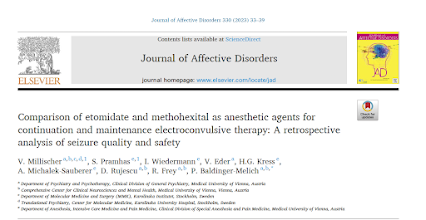Comparing Methohexital and Etomidate in ECT: New Study From Austria
Out on PubMed, from researchers in Austria, is this study:
Comparison of etomidate and methohexital as anesthetic agents for continuation and maintenance electroconvulsive therapy: A retrospective analysis of seizure quality and safety.
J Affect Disord. 2023 Feb 28:S0165-0327(23)00250-1. doi: 10.1016/j.jad.2023.02.085. Online ahead of print.PMID: 36863475
The abstract is copied below:
Background: The ideal hypnotic agent for electroconvulsive therapy (ECT) is still under debate and previous studies comparing etomidate and methohexital have produced conflicting results. This retrospective study compares etomidate and methohexital as anesthetic agents in continuation and maintenance (m)ECT with regard to seizure quality and anesthetic outcomes.
Methods: All subjects undergoing mECT at our department between October 1st, 2014 and February 28th, 2022 were included in this retrospective analysis. Data for each ECT session were obtained from the electronic health records. Anesthesia was performed with either methohexital/succinylcholine or etomidate/succinylcholine. Standard seizure quality parameters, anesthesiological monitoring data, pharmacological interventions and side-effects were recorded.
Results: 573 mECT treatments in 88 patients were included (methohexital n = 458, etomidate n = 115). Seizures lasted significantly longer after using etomidate (electroencephalography: +12.80 s [95 %-CI:8.64-16.95]; electromyogram +6.59 s [95 %-CI:4.14-9.04]). Time to maximum coherence was significantly longer with etomidate (+7.34 s [95 %-CI:3.97-10.71]. Use of etomidate was associated with longer procedure duration (+6.51 min [95 %-CI:4.84-8.17]) and higher maximum postictal systolic blood pressure (+13.64 mmHg [95 %-CI:9.33-17.94]). Postictal systolic blood pressure > 180 mmHg, the use of antihypertensives, benzodiazepines and clonidine (for postictal agitation), as well as the occurrence of myoclonus was significantly more common under etomidate.
Conclusions: Due to longer procedure duration and an unfavorable side effect profile, etomidate appears inferior to methohexital as an anesthetic agent in mECT despite longer seizure durations.
Keywords: Anesthesia; Electroconvulsive therapy, maintenance ECT; Etomidate, Methohexital.
The article is here.
And from the text:
Here are some more very good data comparing methohexital and etomidate as ECT induction agents. The downsides of etomidate (increased procedure duration, more hypertension, more agitation) are quite clear.
Scholars of the ECT anesthesia literature will want to read this report in all its detail.
Kudos to our Austrian colleagues for this contribution.






Comments
Post a Comment